Key takeaways:
- Creativity in game design is centered on relatable narratives and emotional experiences that resonate with players.
- Collaboration with others enhances innovation and offers new perspectives, leading to unique ideas and solutions.
- Taking breaks and exploring different environments can provide fresh insights and spark creativity, overcoming creative blocks.
- Engaging with tools like brainstorming apps and mood boards can liberate thought and stimulate innovative concepts in game development.
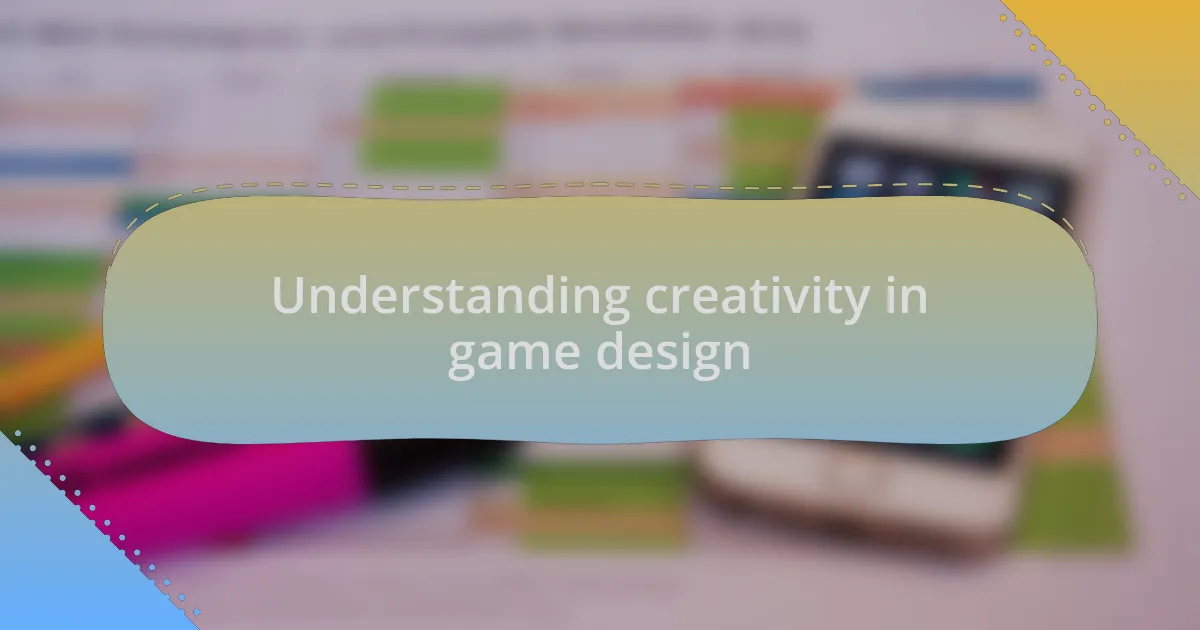
Understanding creativity in game design
Creativity in game design isn’t just about flashy graphics or unique mechanics; it’s about weaving a story that resonates with players. I remember a project where the simplest idea—a lost creature seeking home—sparked a whole world of emotional and engaging gameplay. It made me realize that sometimes, the heart of creativity lies in finding relatable narratives that draw players in.
When designing games, I often ask myself, what experience do I want to evoke? Creativity flourishes when I take a step back and think about the emotions I wish to convey. For instance, in one of my early games, I experimented with creating a sense of nostalgia by incorporating familiar childhood elements. Seeing players smile as they navigated those fond memories was a powerful reminder of how deeply our work can affect others.
Moreover, I believe that collaboration can significantly enhance creativity. I’ve often found that bouncing ideas off fellow designers ignites a spark of innovation that I might not have found alone. There’s something magical about blending different perspectives; it’s like mixing colors on a palette to create something truly unique that stands out in the gaming landscape.
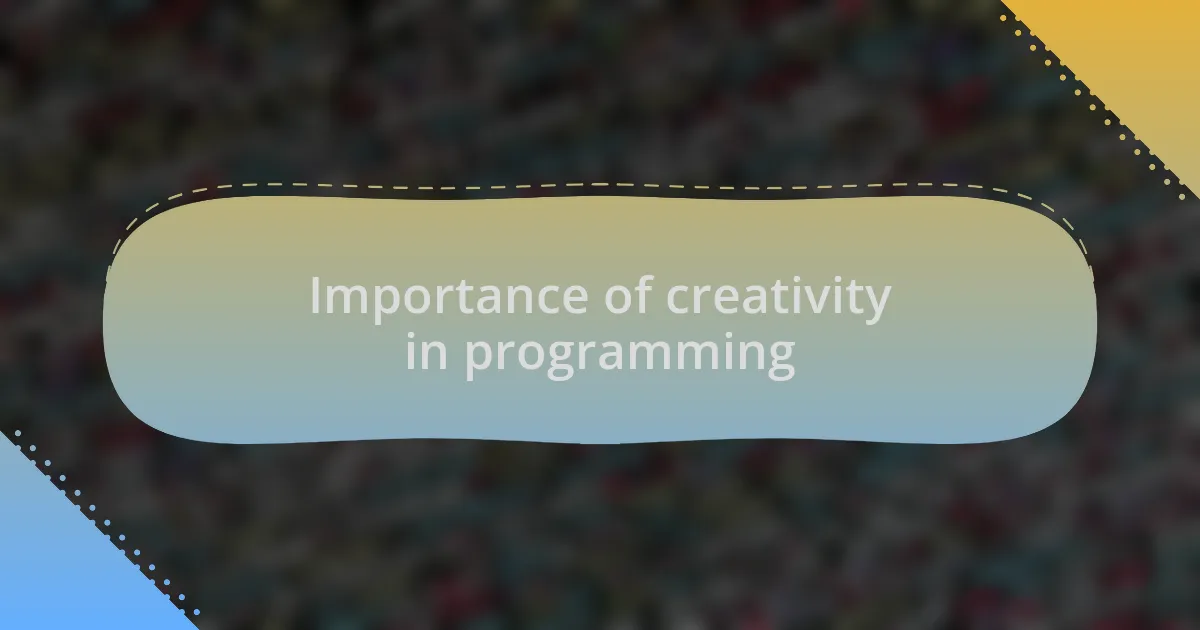
Importance of creativity in programming
Creativity in programming is essential, as it breathes life into the technical aspects of coding. I recall a time when I was faced with a monotonous task of developing a user interface. Instead of sticking to conventional design patterns, I allowed myself to imagine how users would interact with the application. This shift in perspective led to a more dynamic and engaging interface, demonstrating how creative thought can transform standard programming into a delightful user experience.
I often find that the intersection of creativity and programming leads to unexpected breakthroughs. There was an occasion when I stumbled upon a unique algorithm during a brainstorming session. Instead of following the usual practices, I let my imagination roam freely, which opened up an entirely new method of problem-solving. This experience reinforced my belief that fostering creativity can unlock innovative solutions that might otherwise remain hidden in conventional approaches.
It’s fascinating how creative programming can differentiate a product in a saturated market. I’ve watched as small innovations in game mechanics or interface design captivated audiences, sparking not just interest but genuine excitement. Why settle for the ordinary when you can elevate your work through imaginative thinking? Embracing creativity ultimately builds a connection between the programmer and the player, making the entire process more rewarding.
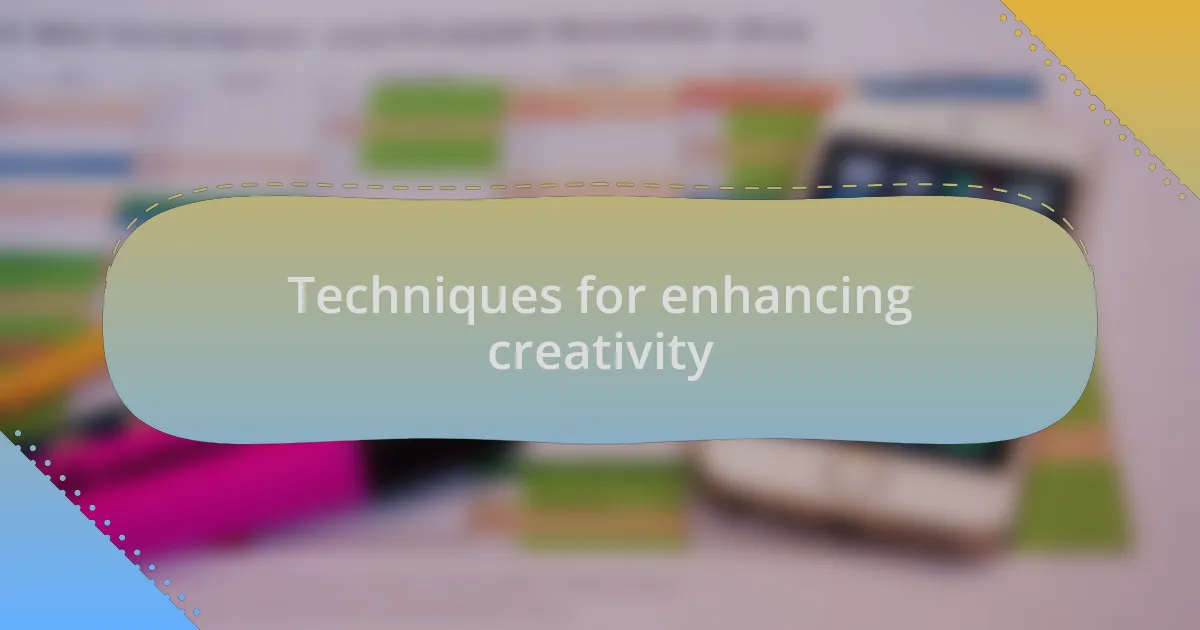
Techniques for enhancing creativity
Exploring different perspectives can be a game-changer in enhancing creativity. I once participated in a game design workshop where we were challenged to develop a concept based solely on a single color. It forced me to think outside my usual box and look for inspiration in unexpected places. This exercise not only sparked unique ideas but also helped me understand how constraints can actually fuel creativity.
Another effective technique is to collaborate with others. I remember teaming up with an artist to create a game about a forgotten myth. Their visual interpretation inspired narrative developments I hadn’t considered. Interacting with different viewpoints not only enriches the project but also pushes you to innovate beyond your typical thought processes. Have you ever noticed how collaboration can bring elements to light that you never thought to explore?
Additionally, I’ve found that taking breaks and stepping away from a project can lead to surprising insights. There was a time I found myself stuck while designing game levels; I decided to go for a walk. To my surprise, ideas began pouring in with every step I took. It made me realize how our minds need space to wander freely. Isn’t it interesting how sometimes the best solutions come when we’re least focused on the problem?
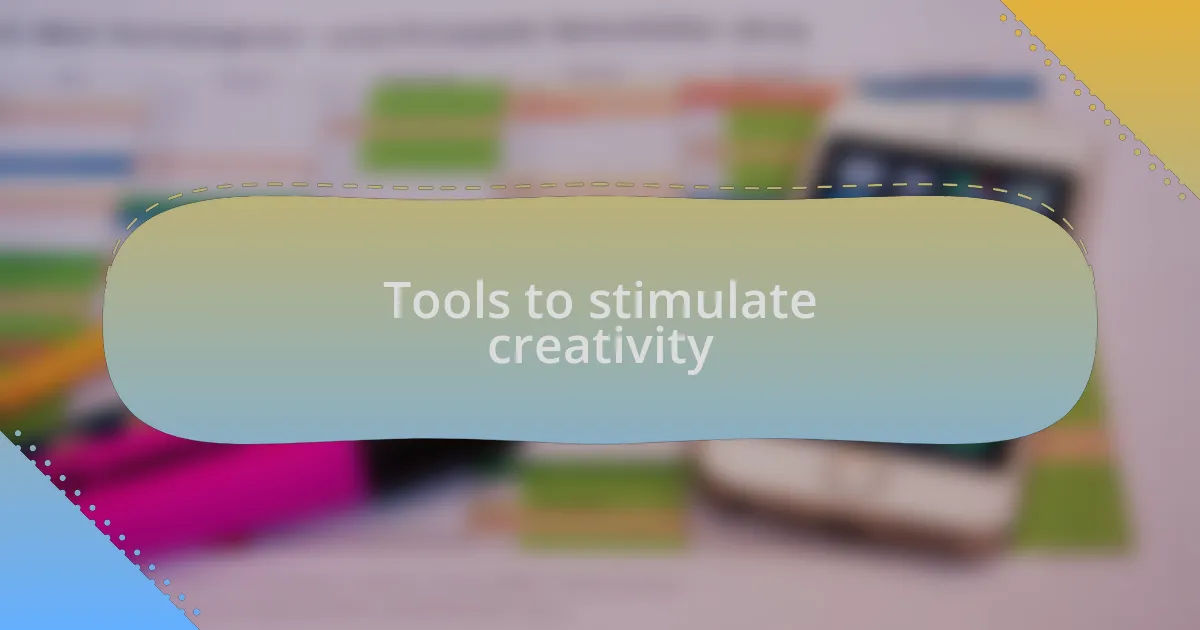
Tools to stimulate creativity
When it comes to tools that stimulate creativity, brainstorming apps have been a game changer for me. I recall a time when I was stuck on a game mechanic that felt stale. Using an app, I jotted down random ideas that flowed in without judgment. It was liberating to see my thoughts laid out, enabling me to connect seemingly unrelated concepts. Have you ever felt lighter just by writing down everything that pops into your mind?
Another invaluable tool is digital mood boards. I love gathering images, colors, and textures that resonate with my vision for a game. Once, while working on a sci-fi project, I created a mood board filled with visuals from nature and architecture. The juxtaposition opened my eyes to how organic and synthetic elements could harmonize. Isn’t it fascinating how visual stimuli can reshape our creative direction?
Moreover, I often turn to online courses and tutorials designed for game design. There’s something inspiring about watching others tackle challenges I face. I distinctly remember an immersive workshop on narrative design that equipped me with new storytelling techniques. Each lesson felt like unlocking a treasure chest of ideas, reminding me that learning never truly stops. How has exploring new concepts influenced your creative journey?
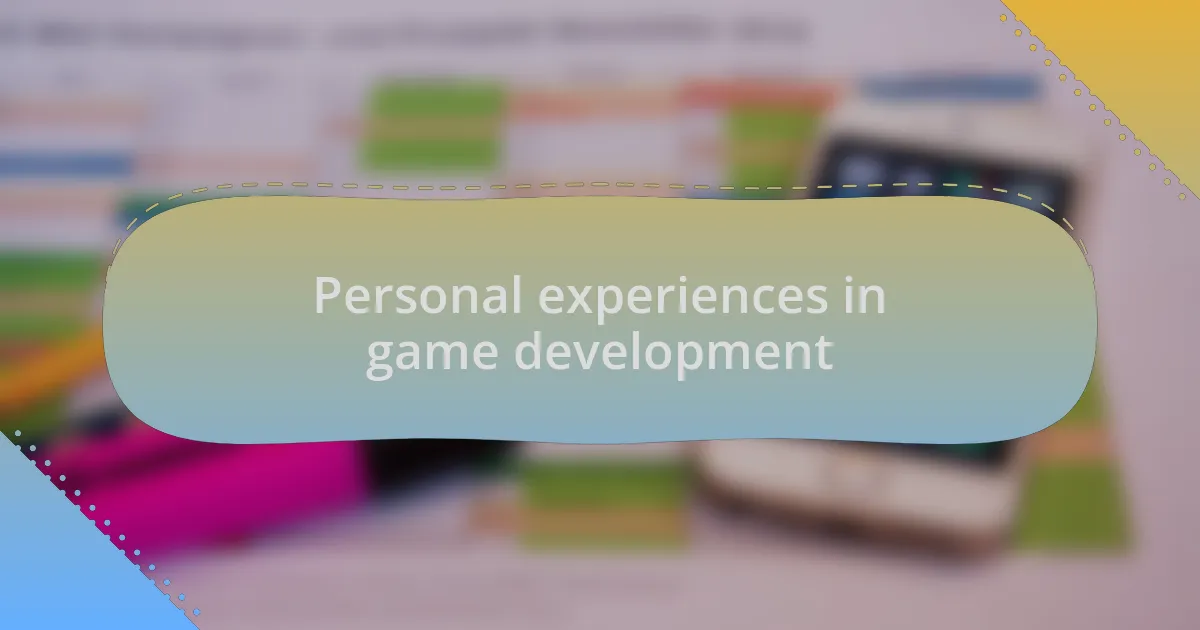
Personal experiences in game development
I have faced my share of challenges while developing games, especially during the prototyping phase. I remember working long nights, trying to lay out the foundation for a platformer, only to realize the mechanics didn’t feel right. It was disheartening, but I found that taking a break and returning with fresh eyes often revealed new perspectives and solutions. Have you ever stepped away from a project, only to come back with a clearer understanding?
One particularly memorable experience involved collaborating with a small team for a semester project. We held brainstorming sessions that burst with energy, each idea sparking others in a delightful chain reaction. I felt a sense of camaraderie as we merged our unique ideas into a cohesive game concept. The way we built on each other’s creativity was a powerful reminder of how collaboration can elevate game design. Have you ever experienced that thrill of teamwork when creating something extraordinary?
In another instance, I ventured into a genre I had limited experience with—puzzle games. It was an uphill battle, filled with moments of self-doubt and frustration as I grappled with how to balance challenge and accessibility. However, immersing myself in player feedback transformed my approach. Their insights ignited a spark within me, leading to innovations I hadn’t initially considered. Don’t you think the player’s perspective can sometimes illuminate the path forward, even in the most complex situations?
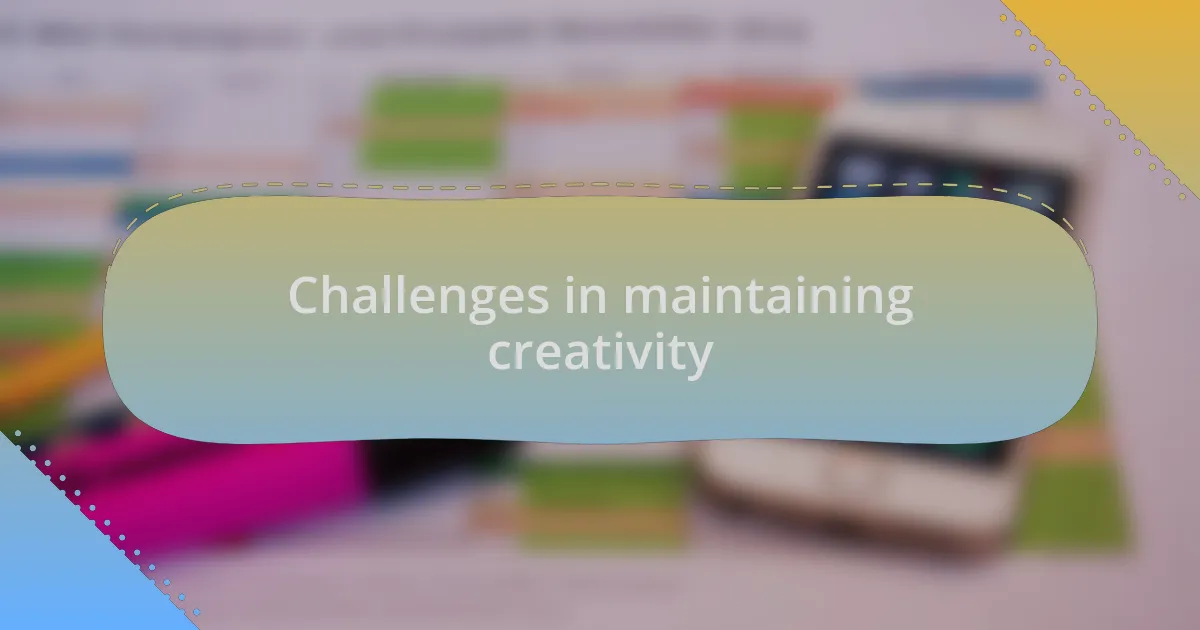
Challenges in maintaining creativity
One major challenge I’ve confronted in maintaining creativity is the overwhelming pressure of deadlines. There were periods when I felt trapped, racing against the clock to get a project finished. It’s like running on a treadmill—you keep going, but the fresh ideas often get lost in the rush. Have you ever felt that urgency stifle your creativity, making it harder to think outside the box?
Another significant hurdle is the inevitable burnout that comes from long hours of focused work. I once found myself staring blankly at my screen, struggling to piece together even the simplest concept. That incessant drain of energy made me question if I was truly cut out for game design. Taking those moments to recharge physically and mentally became essential; I realized that sometimes the best way to foster creativity is to step away entirely. Have you ever discovered that taking a short break sparked your next big idea?
Staying inspired amidst repetitive tasks can also be quite challenging. I remember working on the same mechanics for weeks, and it felt like the initial excitement was wearing off. To combat this, I began experimenting with various media—watching films, reading books, or even playing different games. Those diversions often provided a fresh lens through which I could view my projects. What strategies do you use to keep your creative juices flowing when you find yourself stuck in a rut?
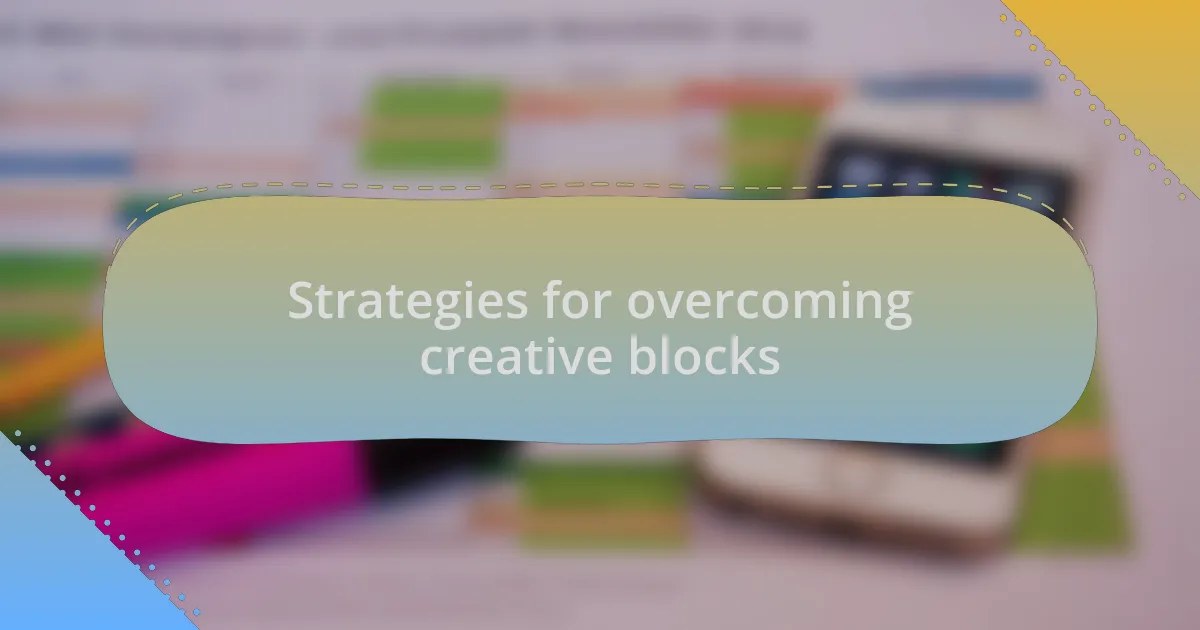
Strategies for overcoming creative blocks
Sometimes, when I hit a creative block, I find that changing my environment can do wonders. I remember one particular afternoon when I took my laptop to a nearby café instead of staying in my usual workspace. The hum of conversations and the aroma of coffee reinvigorated my thoughts, leading to spontaneous brainstorming sessions I didn’t expect. Have you ever noticed how a simple shift in scenery can unlock new ideas?
Another strategy that has worked for me is engaging in collaborative discussions with fellow designers. There was an instance when a friend and I hosted a brainstorming session, and within an hour, we had created a mind map bursting with concepts. The exchange of different perspectives brought life to ideas that had been stagnating in my head. Have you considered reaching out to others when you’re feeling stuck? Those interactions might just lead to a breakthrough.
Finally, I often return to the roots of what inspired me to pursue game design in the first place. Reminiscing about the games that shaped my childhood can reignite that initial spark of creativity. One evening, I revisited a classic game that once captivated me, and within moments, I was filled with innovative concepts. Reflecting on our inspirations can be a powerful antidote to creativity’s struggles. What are your sources of inspiration that you turn to when the flow of ideas runs dry?